| 109
|
CHAPTER 17
Twist Hoses (and Foot Tubes)
to Help Diego Walk
Foot Tubes That Didn't Work
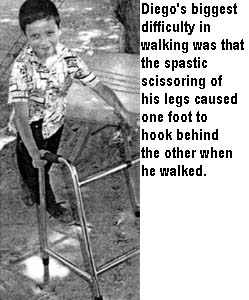
DIEGO is a bright, enthusiastic 8-year old boy with
spastic cerebral palsy. When his family first took him to PROJIMO, he could
walk with a walker, but with difficulty. Without his walker, he could not
walk at all. A combination of in-turned feet, scissoring legs, and jerky
exaggerated movements made it extremely difficult for him to take steps.
With each step, as he brought his back foot forward, the toe of his shoe
would begin to hook around the heel of his weight-bearing foot, and he had
to drag and jerk it free.
Nonetheless, Diego made a great effort to walk, jerking himself back
and forth across the room. "If only my feet ... didn't bump ... together!"
said Diego, his voice jerky and high pitched from the spasticity in his
throat and tongue.
"We'll see what we can do so your feet don't bump together so much when
you walk," said Mari. "Great!" said Diego.
FOOT TUBES THAT ROTATE AND SEPARATE THE LEGS.
To help Diego's feet turn outward, and to help his legs separate more when
he walked, the team first tried a modification of the foot-tube design (see
Chapter 16). They felt this might work
because, when the boy relaxed, they could easily point his feet in opposite
directions.

To both rotate and separate Diego's legs during the night, Polo made a
device with 2 plastic bottles mounted on a thin board. Diego tried it and
thought it might be OK.

Eager to walk better, he promised to use it often. Mari suggested he wear
it part of the night, and when he relaxed or watched TV.

But when the family returned to PROJIMO a few weeks later, Diego was
discouraged.
"The thing is uncomfortable for him," said his mother.
"It's killing me!" said Diego with a shy smile. "Isn't
there a better way to straighten my stupid feet?"
|
| 110
|
| "We could try torsion cables,"
suggested Mari. "Try what?" asked Diego, doubtfully.
"Rubber tubes from your shoes to your waist, that twist your feet
outward," Mari explained. "Interested?"
The boy frowned importantly. "Why not!"
A Trial with Elastic Spiral Leg Bands
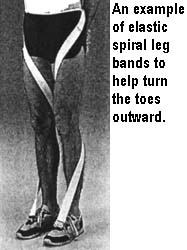
Because the plastic bottle foot-tubes had not been successful, Mari
wanted to do an experiment to see if twist cables were likely to work. She
attached strong elastic straps to the tops of Diego's shoes and wound them
up and around his legs, stretching them enough to pull his toes outward.
She attached the upper ends behind his back. Then she asked Diego to walk
with his walker. She found he walked without his toes turning in as much.
And he stumbled less.
Plug-in Twist Hoses (Torsion Cables)

Reassured that the cables might help, Mari called Armando from the
brace shop to see Diego. She asked him if he could make twist-cables for
the boy.
"I think so," said Armando. "We have some old rubber hose from the
gas-welder in the wheelchair shop. That should work for the cables."
Diego already had a new pair of shoes that fit over his below-knee
orthopedic braces. "Do you think you can make the cables so that Diego can
attach and remove them from his shoes easily?" Mari asked Armando. "That
way he can break them in bit by bit, without much discomfort." Diego
nodded with approval.
"I'll see what I can do," said Armando. Armando designed and made
twist-cables that could easily plug in and out of Diego's shoes. First he
made a metal waist band, to which he riveted a leather belt with a buckle
of self-sticking tape (Velcro). On both sides of the belt he fastened a
metal tube that held the upper ends of the pieces of welding hose.
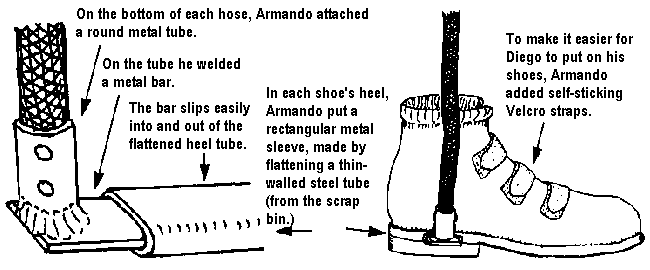
 | On the bottom of each hose, Armando attached a round metal tube. |
 | On the tube he welded a metal bar. |
 | The bar slips easily into and out of the flattened heel tube. |
 | In each shoe's heel, Armando put a rectangular metal sleeve, made by
flattening a thin-walled steel tube (from the scrap bin.) |
 | To make it easier for Diego to put on his shoes, Armando added
self-sticking Velcro straps. |
|
| 111
|
| SURPRISING RESULTS. When
the twist tubes were finished, Diego tried them. They were easy to put on.
First he put on his braces and shoes, next the waist belt, and then he
plugged the cables into his shoes. Armando showed him how to twist the
cables before plugging them in, so that they rotated his feet outward.
An unplanned advantage to the plug-in feature was that
the boy himself could experiment with the amount of twist he wanted. The
twisting force on his feet depended on how many turns he gave the cables
before plugging them into the heels of his shoes.

As soon as the cables were attached, Diego began to walk with his
walker. To his own and his parents surprise, almost immediately he was
able to swing one foot past the other without the toe of that shoe bumping
into the heel of the other. This made walking a lot easier.
Mari watched carefully as Diego walked. She was pleased to see that
although his feet now turned outward slightly, his knees pointed straight
forward. (If the cables had caused the knees to twist outwardly [valgus],
this could mean that they were causing a harmful twist at the hips.)

Diego walked back and forth with his walker a few times. Then, to
everyone's amazement, he let go of the walker and began to walk
without it! At first he wobbled and almost fell. But soon he
figured out how to balance, and proudly walked back and forth on the
porch. Diego grinned ear-to-ear as he walked. His mother wept with
delight. Everyone applauded both for Diego and Armando.
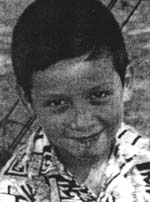
Diego's middle name also happens to be Armando. In the adventure of
building and trying the new device, the two Armando's formed a sort of a
bond. (Armando, the brace maker, had polio as a baby and had begun to walk
only when he, too, was 8 years old - also with PROJIMO's help.) When Mari
asked Diego Armando what he wanted to do when he grew up, the boy replied,
"I want to make braces and help other kids learn to walk, like my
tocayo does." (Tocayo is Spanish for name-sake.)
If Diego follows through on his dream, he will be the fourth youngster
who first came to PROJIMO to be fitted with braces, and who then became a
community-based brace maker himself. |
| 112
|
A Walker with a Foot Separator - in Bangladesh
Different programs find different ways to deal with similar problems.
At the Center for Rehabilitation of the Paralyzed, in Bangladesh,
there was a little girl named JANAKI, who had cerebral
palsy. Like Diego, she had difficulty walking with a standard walker. Her
spastic legs tended to scissor, and would bump against each other when she
tried to take steps.
After experimenting with a number of alternatives, the staff made a
simple metal walker for her which had bars positioned between her legs.
The lower bar was covered with a sponge roll. The roll was upholstered
with smooth plastic, so that her lower legs would slide against it as she
walked. With this device, Janaki was able to walk much better. Because the
bar held her feet somewhat apart, she also had better balance.
The walker also had a small seat on which Janaki could sit when she
wanted to rest.
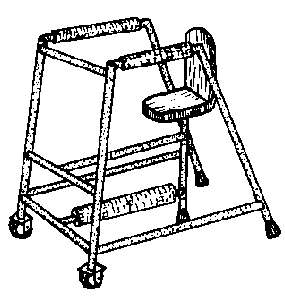
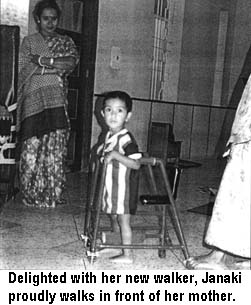
|
|